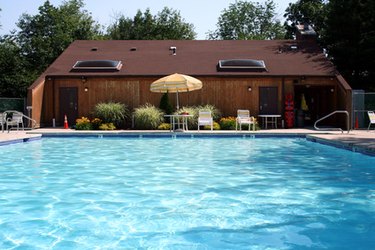
Fiberglass is a popular option for many residential pools. Although it costs much more than vinyl liners and often more than concrete options, fiberglass comes in set forms that are easy to install and often include lighting fixtures and all the plumbing necessary for the pool. The fiberglass sides of the pool resist wear well and require less use of chemicals than other options. However, fiberglass pools also have some hazards associated with them.
Peeling
Video of the Day
Where fiberglass meets a tile line or concrete edge, there is some danger of the fiberglass fibers peeling away, especially with constant exposure to both water and warm air. As this fiberglass peels it can float away on the pool where it becomes a cutting or ingestion hazard--or it can work its way into the soil, which is also undesirable. High-quality pools do not tend to have this problem, but cheaper fiberglass pools can peel, especially at the edges.
Video of the Day
Landscaping Problems
Installers cannot mold fiberglass pools to a particular design; homeowners must choose from the set shapes available. Problems occur when homeowners try to work a fiberglass pool into a landscaping design where it will not fit, where the customizable concrete pool would be a better fit. Fiberglass pools can prevent plant roots from developing properly if installer place them too close to growing areas, and digging for a misplaced pool may cause piping or sprinkler system damage and contamination.
Cracks
Fiberglass pools are coated in a gel-like paint designed to protect them. Over time, this gel layer tends to develop cracks, which can be caused by simple wear, highly acidic water, or even tree roots pushing up from the surface. Not only do these cracks raise the likelihood of leaks, but they can also scrape and cut sensitive feet if they grow sharp enough.
Underground Leaks
Sometimes homeowners have fiberglass pools placed on a sandy substrate or a similar type of dirt that eventually settles or sinks down during rainy seasons. This literally drags the pool down a little more into the ground--rarely enough to be perceptibly, but sometimes enough to damage the pool plumbing system. This leaks pool water and its toxic chemicals into the surrounding soil until homeowners have the leak repaired.